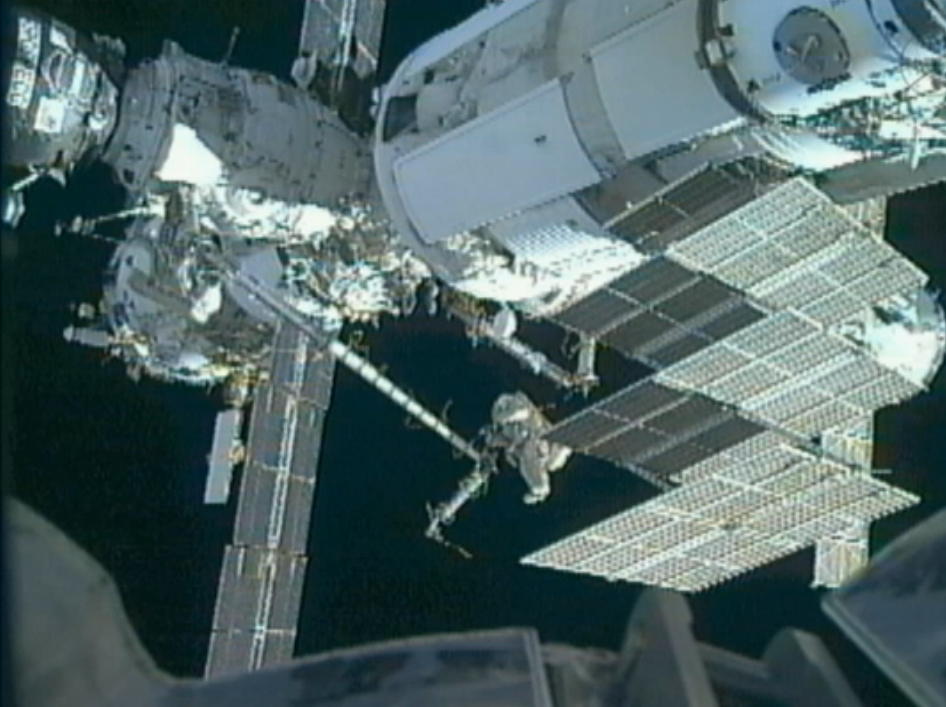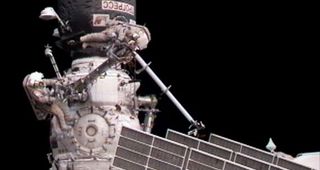2 Russian Cosmonauts Move Space Station Crane in 6-Hour Spacewalk

This story was updated at 4:21 p.m. ET.
Two spacewalking cosmonauts moved a bulky zero-gravity crane to a new home on the International Space Station Thursday (Feb. 16), but ran out of time before they could beef up the orbiting lab's armor against space junk.
Russian spaceflyers Oleg Kononenko and Anton Shkaplerov spent more than six hours working outside the space station during the spacewalk. Their main goal was to move a space construction crane, called Strela, from the Pirs docking port on the bottom of the space station to a rooftop module called Poisk.
The spacewalkers had planned to install new metal shields on the station's Russian segment to protect it against damage from micrometeorites and space junk. But the crane relocation work ran long and they had to skip the shield installation task.
Flight controllers at Russia's Mission Control center near Moscow told the cosmonauts they did a wonderful job, despite the skipped work. The spacewalk began at 9:31 a.m. EST (1431 GMT) and lasted six hours and 15 minutes.
For Russia's Federal Space Agency, the crane relocation was the critical item on today's spacewalk to-do list. The move ensures the crane will remain aboard the space station when the Pirs docking port is discarded to make way for Russia's new Multipurpose Laboratory Module, which is due to arrive at the outpost by 2013, NASA officials said.
It was tough work in space, with the cosmonauts falling more than an hour behind schedule in order to move the unwieldy crane without damaging other parts of the space station. Mission controllers reminded the spacewalkers to use their spacesuit cooling systems to avoid overheating from their exertion. [Photos: Building the Space Station]
Get the Space.com Newsletter
Breaking space news, the latest updates on rocket launches, skywatching events and more!
The cosmonauts agreed.
"We're all hot and bothered," one of the spacewalkers said at one point.

Unlike the space station's Canadian-built Canadarm2 robotic arm, the Strela cranes are unpowered. They are operated by a hand crank that cosmonauts turn in order to extend the crane to a desired length.
"That's a hand-operated telescoping pole," NASA's space station spacewalk officer Glenda Brown explained in a video.
In addition to the crane work, the cosmonauts also took took swab samples of areas beneath the insulation covering the station's Pirs module. Russian scientists want to test the samples to see if any organisms have survived beneath the many layers, NASA officials said. The spacewalkers also installed a new materials experiment called Endurance before wrapping up their work.
Kononenko and Shkaplerov are two members of the six-man Expedition 30 crew currently living aboard the International Space Station. Two Americans, another Russian and a Dutch astronaut round out the crew.
Today's spacewalk is the 162nd spacewalk dedicated to the construction and maintenance of the International Space Station, which was built by five different space agencies representing 15 countries. Construction of the $100 billion space station began in 1998.
You can follow SPACE.com Managing Editor Tariq Malik on Twitter @tariqjmalik. Follow SPACE.com for the latest in space science and exploration news on Twitter @Spacedotcom and on Facebook.
Join our Space Forums to keep talking space on the latest missions, night sky and more! And if you have a news tip, correction or comment, let us know at: community@space.com.

Tariq is the Editor-in-Chief of Space.com and joined the team in 2001, first as an intern and staff writer, and later as an editor. He covers human spaceflight, exploration and space science, as well as skywatching and entertainment. He became Space.com's Managing Editor in 2009 and Editor-in-Chief in 2019. Before joining Space.com, Tariq was a staff reporter for The Los Angeles Times covering education and city beats in La Habra, Fullerton and Huntington Beach. In October 2022, Tariq received the Harry Kolcum Award for excellence in space reporting from the National Space Club Florida Committee. He is also an Eagle Scout (yes, he has the Space Exploration merit badge) and went to Space Camp four times as a kid and a fifth time as an adult. He has journalism degrees from the University of Southern California and New York University. You can find Tariq at Space.com and as the co-host to the This Week In Space podcast with space historian Rod Pyle on the TWiT network. To see his latest project, you can follow Tariq on Twitter @tariqjmalik.